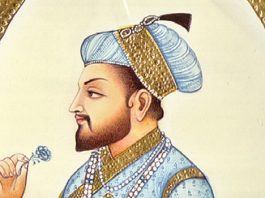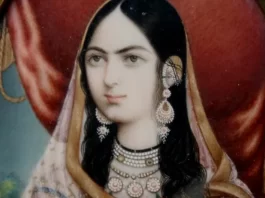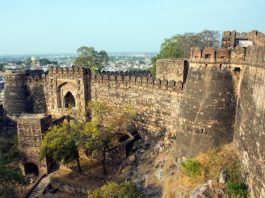Mangal Pandey (19 July 1827 – 8 April 1857) was an Indian soldier who played a key role in the events immediately preceding the outbreak of the Indian rebellion of 1857. In early 1857, Pandey served as a soldier in the 34th Bengal Native Infantry regiment of the British East India Company. On 29 March, he attacked and killed two British officers in the cantonment of Barrack pore and was subsequently apprehended and hanged. His actions were a catalyst for the rebellion, which began a few weeks later.

Born in a village of Ballia district in Uttar Pradesh, in a Hindu Brahmin family in the North Indian state of Uttar Pradesh, Pandey enlisted in the Bengal Native Infantry in 1849. He was promoted to the rank of havildar (sergeant) in 1856. By early 1857, the regiment in which he was serving was scheduled to be disarmed and disbanded as part of a wider plan to reduce the size of the Bengal Army. On 19 March, Pandey overheard two British officers, Lieutenant Baugh, and Adjutant Humphrys, discussing the impending disbandment and the order to disarm the regiment. His life has also been portrayed in several cinematic productions and literature.
Childhood:
Mangal Pandey was born on July 19, 1827, in the village of Nagwa in Ballia district, in the state of Uttar Pradesh, India. He was the son of a Bhumihar Brahmin, Diwakar Pandey, who worked as a small-time revenue collector.
As a child, Mangal Pandey was said to be courageous and had a strong sense of justice. He received his early education in a madrasa in his village and later moved to the town of Varanasi for further studies.
In 1849, at the age of 22, Mangal Pandey joined the British East India Company’s army and was posted to Barrackpore, near Calcutta (now Kolkata). He was known to be a good marksman and a skilled horseman and was respected by his fellow soldiers for his bravery and sense of honor.
However, his life took a dramatic turn in 1857 when the Indian soldiers in the British army revolted against their British officers. Mangal Pandey played a key role in this rebellion, which is now known as the Indian Rebellion of 1857 or the First War of Indian Independence. His actions and bravery in the revolt made him a hero in the eyes of many Indians, and he is remembered as one of the key figures of the Indian freedom struggle.
Mutiny:
Mangal Pandey was an Indian soldier who played a key role in the events leading up to the 1857 Indian Rebellion. Born in Uttar Pradesh, he joined the British East India Company’s army in 1849. He was serving in the Bengal Native Infantry regiment when he became involved in a dispute with a superior officer. English Army used musket, which was believed to have the fat of pig and cow in front of the bullet, which sepoys had to remove with their mouth. They were asked to do that. Hindu sepoys denied using that rifle. English army threatened them to take back their uniform and gun. Indian’s religious sentiments were hurt by this act. They started to have anger against English Army. The following day, Pandey approached Lieutenant Baugh and asked him when the regiment would be disarmed. When Baugh told him the order had not been received, Pandey feigned relief and left. The next day, 21 March, he again approached Baugh and asked about the disarmament order. Baugh again told him that the order had not yet been received. On the afternoon of 29 March 1957, Lieutenant Baugh was informed that some men of his regiment were excited, and one of them, Mangal Pandey, in front of the regiment guard room by the parade ground, was pacing. He was armed with a loaded gun and calling upon other men to revolt. But due to fear, no one stood with him.
Pandey then drew his pistol and shot Baugh in the chest, killing him instantly. Sepoy Sheikh Paltu tried to safe Lieutenant Baugh l. He then tried to shoot Humphrys, but the gun misfired. Humphrys ran towards the barracks, shouting, “Murder! Sepoys mutiny!” Pandey was subsequently apprehended and hanged on 8 April 1857. His actions were a catalyst for the outbreak of the rebellion, which began a few weeks later.
Aftermaths:
The government investigated the matter, and on 6 May, the regiment disbanded with disgrace as collective punishment. Shaikh Paltu was promoted to sergeant for his action on 29 March. He was murdered soon after the regiment disbanded. The Indian historians believe that the regiment has a recent good record. In inquiry, the court had not found evidence of the connection with that unrest.
Motivation:
The person behind the Mangle Pandey’s behavior remained unknown. During the incident itself, he shouted to other sepoys: “come out – the Europeans are here”; “from biting these cartridges, we shall become infidels,” and “you sent me out here. Why don’t you follow me”. At his court-martial, he said that he had been taking opium and bangh and was unaware of his actions on 29 March.
Consequences:
Mangle Pandey’s act and his punishment paved the way for what is known as the Indian Rebellion of 1857. That’s why he is called the first revolutionary of the war of independence. The news of this incident was spread everywhere and raised other series of mutinies that broke out in the following months. Modern Indian scholars portray him as the mastermind behind the whole story of revolt against the British Raj.
Film and literature:
A stage play titled “the Roti Rebellion” was written and directed by Supriya Karunakaran and covered the life story of Mangle Pandey. A film acted by Amir Khan and Rani Mukharji was released on 12 August 2005, directed by Ketan Mehta.
Commemoration:
A post stamp was bearing the image of Mangle Pandey issued by the government of India on 5 October 1984. Delhi-based artist C.R Pakrashi designed this stamp. A park at Barrack pore where Pandey attacked British Officer and hanged subsequently, named after Shaheed Mangal Pandey Maha Udyan has been set up.
Death:
In March 1857, he was part of a group of soldiers who refused to bite the cartridges of their new Enfield rifles, which were rumored to be greased with beef and pork fat. This action sparked a mutiny in his regiment, which quickly spread to other parts of the country. On 10 May 1857, Pandey attacked and killed two British officers in the town of Barrack pore. He was later captured and hanged on 8 April 1858 at 30. HE served in the military from 1849 to 1857. His death was a rallying point for the rebels and helped spark the nationwide uprising known as the First War of Independence.
Summary of his life:
Mangal Pandey was an Indian soldier who played a key role in the events leading up to the 1857 Indian Rebellion. Born in Uttar Pradesh, he joined the British East India Company’s army in 1849. He was serving in the Bengal Native Infantry regiment when he became involved in a dispute with a superior officer. This led to his court-martial and subsequent execution in 1857. His death is seen as a catalyst for the rebellion, which began a few months later. Pandey has been hailed as a national hero in India, and his story has been told in several films and television series.
Reference Links:
https://en.wikipedia.org/wiki/Mangal_Pandey#Commemoration



